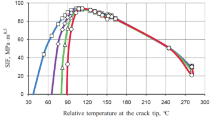Abstract
On the basis of a new local probabilistic criterion of brittle fracture, a local criterion of ductile fracture proposed by the authors earlier, and the obtained approximate solution of the problem of stress-strain state near the crack tip, we develop a probabilistic model for the prediction of the crack resistance of pressure-vessel steels. The model enables one to predict the dependence of K Ic on temperature for any given probability of brittle fracture and the influence of the thickness of the specimen on K Ic. Bu using this model, we can also describe the temperature range of the brittle-ductile transition. The results of numerical calculations are compared with the experimental data for 15Kh2MFA pressure-vessel steel. It is shown that the proposed model fairly well describes the spread in the experimental data on the crack resistance of this type of steel.
Similar content being viewed by others
References
B. Z. Margolin, A. G. Gulenko, and V. A. Shvetsova, “Probabilistic prediction of the crack resistance of nuclear pressure-vessel steels on the basis of a local approach. Part 1,”Probl. Prochn., No. 1, 5–20 (1999).
B. Z. Margolin, G. P. Karzov, and V. A. Shvetsova, “Brittle fracture of nuclear pressure-vessel steels. Part 2. Prediction of fracture toughness,”Int. J. Pres. Ves. Piping,72, 89–96 (1997).
R. M. McMeeking, “Finite deformation analysis of crack tip opening in elastic-plastic materials and implications for fracture initiation,”J. Mech. Phys. Solids,25, 357–381 (1997).
J. R. Rice and M. A. Johnson, “The role of large crack tip geometry changes in plane strain fracture,” in:Inelastic Behavior of Solids, McGraw-Hill, New York (1970), pp. 641–672.
J. R. Rice and G. F. Rosengren, “Plane strain deformation near a crack tip in hardening materials,”J. Mech. Phys. Solids,16, 1–12 (1968).
J. W. Hutchinson, “Singular behavior at the end of a tensile crack in hardening materials,”J. Mech. Phys. Solids,16, 13–31 (1968).
L. M. Kachanov,Fundamentals of the Theory of Plasticity [in Russian], Nauka, Moscow (1969).
I. R. Dixon, “Stress and strain distributions around cracks in sheet material having various work-hardening characteristics,”Eng. Fract. Mech.,1, 224–244 (1965).
R. Hill,The Mathematical Theory of Plasticity, Clarendon, Oxford (1950).
G. P. Karzov, B. Z. Margolin, and V. A. Shvetsova,Physicomechanical Simulation of Fracture Processes [in Russian], Politekhnika, St. Petersburg (1993).
Y. Neuber,Kerbspannungslehre, Springer, Berlin (1958).
L. A. Kopel'man,Resistance of Welded Joints to Brittle Fracture [in Russian], Mashinostroenie, Leningrad (1978).
B. Z. Margolin, G. P. Karzov, V. A. Shvetsova, and V. I. Kostylev, “Modelling for transcrystalline and intercrystalline fracture by void nucleation and growth,”Fatigue Fract. Eng. Mater. Struct.,21, No. 2, 123–138 (1998).
F. M. Beremin, “A local criterion for cleavage fracture of a nuclear pressure-vessel steel,”Met. Trans.,14A, 2277–2287 (1983).
K. Wallin, “The size effect inK I c results,”Eng. Fract. Mech.,22, 149–163 (1985).
G. P. Karzov, B. T. Timofeev, and V. P. Leonov,Welded Pressure Vessels: Strength and Durability [in Russian], Mashinostroenie, Leningrad (1982).
H. -Chr. Zeislmair, “Factors affecting fracture toughness,” in:Werkstoffkunde Eisen und Stahl. Teil I: Grundlagen der Festigkeit, der Zähigkeit und des Bruchs, Verlag Stahleisen, Düsseldorf (1983), pp. 332–369.
J. Landes and D. McGabe, “The effect of section size on the transition temperature behavior of structural steels,” Westinghouse Scientific Paper 82-1D7-METAL-P2 (1982).
Yu. F. Balandin, I. V. Gorynin, Yu. I. Zvezdin, et al.,Structural Materials of Nuclear Power Plants [in Russian], Énergoatomizdat, Moscow (1984).
G. J. Hahn and S. Shapiro,Statistical Models in Engineering, Wiley, New York (1967).
A. Rosenfield and D. Shetty, “Lower-bound fracture toughness of a reactor-pressure-vessel steel,”Eng. Fract. Mech.,14, 833–842 (1981).
J. Landes and D. McGabe, “Statistical characterization of fracture in the transition region,” Westinghouse Scientific Paper 79-1D3-JINTF-P4 (1979).
K. Ando, K. Magani, and K. Tuji, “Probabilistic aspects of cleavage crack initiation sites and fracture toughness,”Fatigue Fract. Eng. Mater. Struct.,15, 1171–1184 (1992).
K. Wallin, “The scatter inK Ic results,”Eng. Fract. Mech.,19, 1085–1093 (1984).
J. F. Knott,Fundamentals of Fracture Mechanics, Butterworths, London (1973).
A. Ya. Krasovskii,Brittleness of Metals at Low Temperatures [in Russian], Naukova Dumka, Kiev (1980).
B. Z. Margolin and V. A. Shvetsova, “A criterion of brittle fracture: Physicomechanical approach,”Probl. Prochn., No.2, 3–16 (1992).
B. Z. Margolin, V. A. Shvetsova, and G. P. Karzov, “Brittle fracture of nuclear pressure-vessel steels. Part 1. Local criterion of cleavage fracture,”Int. J. Pres., Ves. Piping,72, 73–87 (1997).
B. Z. Margolin, V. A. Shvetsova, and A. Ya. Varovin, “Preliminary compression of a material as a factor of changes in the mechanism of brittle fracture of bcc metals,”Probl. Prochn., No.4, 5–18 (1996).
B. Z. Margolin and V. A. Shvetsova, “Local criterion for cleavage fracture: structural and mechanical approach,”J. Phys. IV,6, 225–234 (1996).
Additional information
TsNII KM “Prometei,” St. Petersburg, Russia. Translated from Problemy Prochnosti, No. 2, pp. 5–22, March–April, 1999.
Rights and permissions
About this article
Cite this article
Margolin, B.Z., Gulenko, A.G. & Shvetsova, V.A. Probabilistic prediction of the crack resistance of nuclear pressure-vessel steels on the basis of a local approach. Part 2. Strength Mater 31, 107–119 (1999). https://doi.org/10.1007/BF02511100
Received:
Issue Date:
DOI: https://doi.org/10.1007/BF02511100




